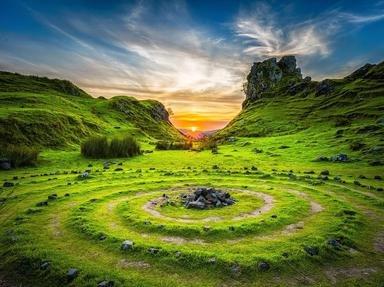Quiz Answer Key and Fun Facts
1. Year 1100: With the death of Godfrey of Bouillon, "Defender of the Holy Sepulchre," rule of Jerusalem is passed to his older brother, the Count of Edessa, who first takes the title of "King of Jerusalem." Who was this nobleman, who ruled Jerusalem as king until his death in 1118, and who shared his name with a later King of Jerusalem known as "the Leper"?
2. Year 1200: Although I am extremely skeptical of this claim, some websites say the Chinese invented something on 1 July, 1200, which is very common today. What device designed today for ocular protection do most websites say we see historically first in China in the thirteenth century?
3. Year 1300: After Caerlaverock Castle fell to the English during the First War of Scottish Independence, a lull in the fighting occurred, during which the Pope sent a letter to England's king demanding he withdraw from Scotland. Consequently, on 30 October, 1300, the king returned to England and bided his time until launching his sixth campaign into Scotland in July of 1301. Can you identify the pope and the king involved?
4. Year 1400: We'll stay in England for the year 1400. The country saw two significant deaths in a monarch and the poet who gave us such expressions as "murder will out," "every man for himself," and "it is no child's play." Who were these two individuals?
5. Year 1500: Two explorers, sponsored by the same kingdom, made two significant voyages in 1500. The first, Pedro Alvares Cabral, was blown off course from a voyage around Africa and ended up making landfall in South America, claiming what would later be that continent's largest country. The second, Gaspar de Corte-Real, voyaged as far as Greenland, and then returned the next year to make landfall in Labrador to become the first European since the Vikings to land in North America. What nation sponsored these explorers?
6. Year 1600: Although Tokugawa Ieyasu did not consolidate complete control of Japan with his shogunate until 1603, most historians point to the decisive battle on 21 October of 1600 as the determining factor in his success. What was the name of this battle whose outcome saw the execution of his rivals Ishida Mitsunari, Konishi Yikinaga, and Ankokuji Ekei and the decline of the Toyotomi clan?
7. Year 1700: The siege of Tönning in March of 1700 opened the Great Northern War. Although as many as 15-16 separate states were involved in the conflict, which lasted 21 years, two major powers and their rulers led the "festivities". Can you name them?
8. Year 1800: Prussian geographer Alexander von Humboldt spent four months exploring the basin of South America's second largest river, covering over 1,700 miles of largely uninhabited country and discovering, among other things, electric eels and pink river dolphins. What river is this, which is also the world's fourth largest in terms of average discharge and empties into the Atlantic Ocean through Venezuela?
9. Year 1900: On the rainy and foggy night of 30 April, 1900, an Illinois Central engineer of the "Cannonball Express" passenger train finished a run in Memphis, Tennessee. Learning that the scheduled engineer for the return run was ill, he volunteered to replace him. Traveling at 75 miles per hour to make up for a late restart, the "Cannonball" rear-ended a stopped freight train near Vaughn, Mississippi, killing the engineer. What was that engineer's name?
(Vaughn is one of the correct spellings of the place. Please don't send corrections).
10. Year 2000: On 10 September, 2000, a musical closed on Broadway after 7,485 performances, making it at the time, the record-holder for Broadway longevity, a record that would not be passed until 9 January, 2006. What was this musical in which Marlene Danielle performed for its entire run, from 1982 to 2000?
Source: Author
shvdotr
This quiz was reviewed by FunTrivia editor
bloomsby before going online.
Any errors found in FunTrivia content are routinely corrected through our feedback system.

